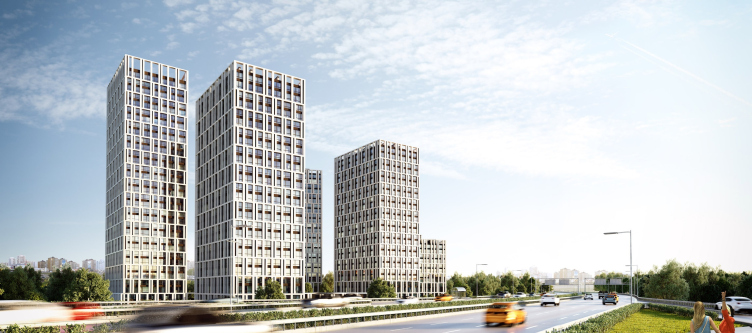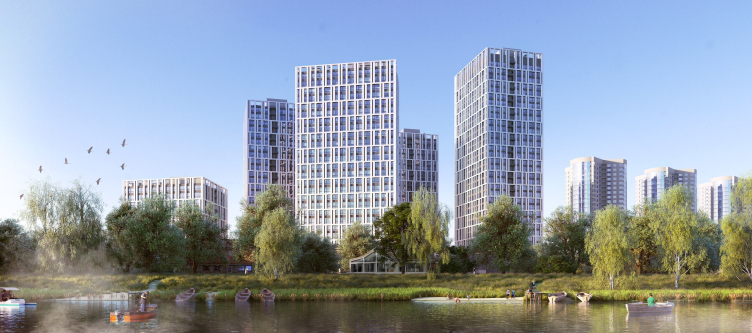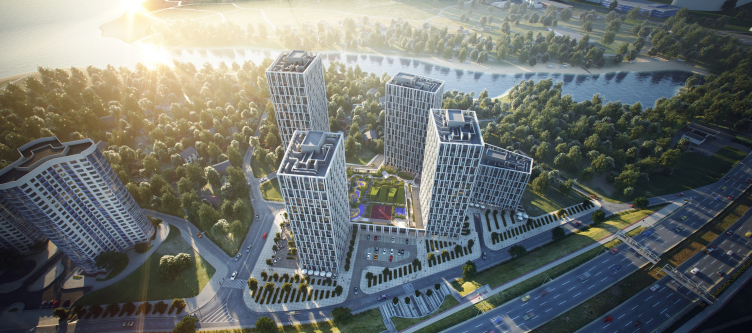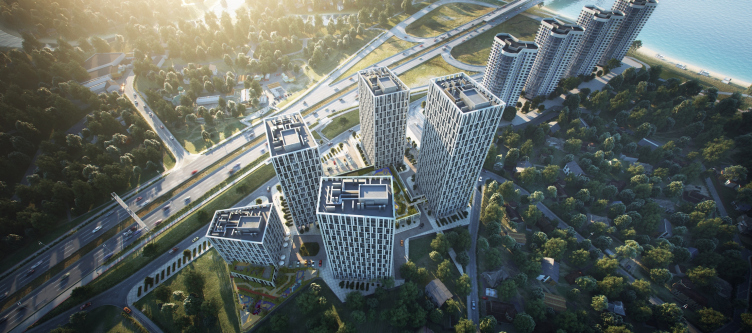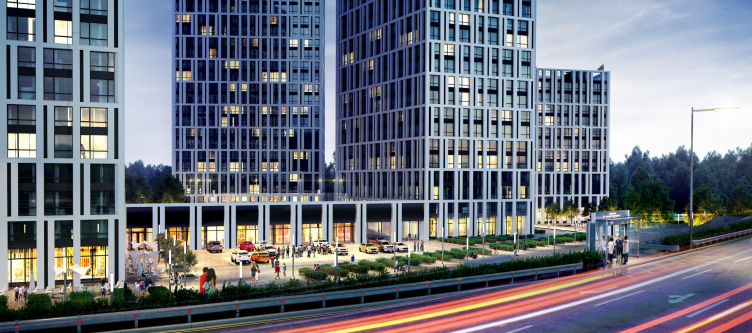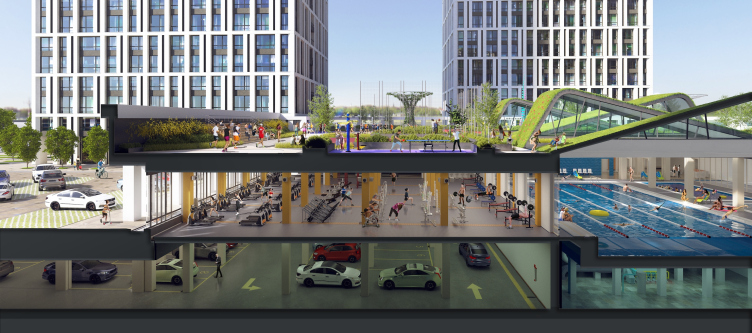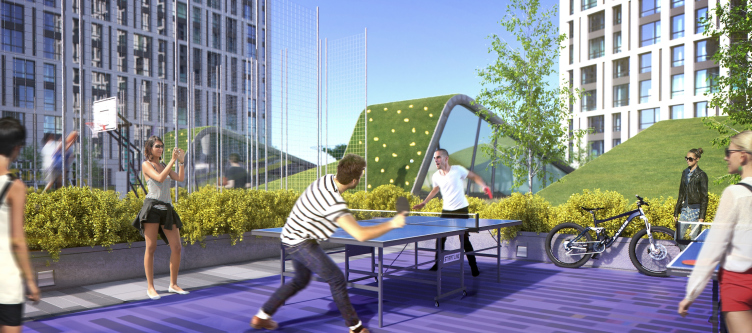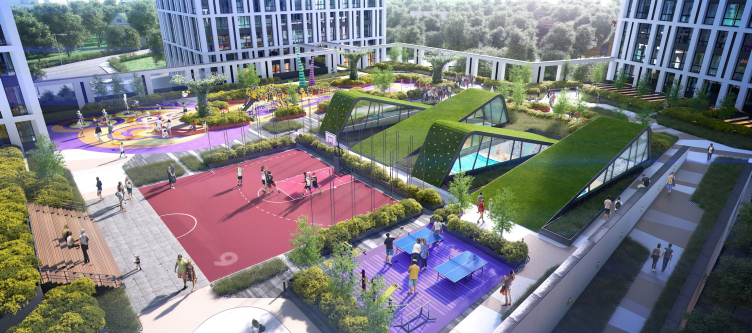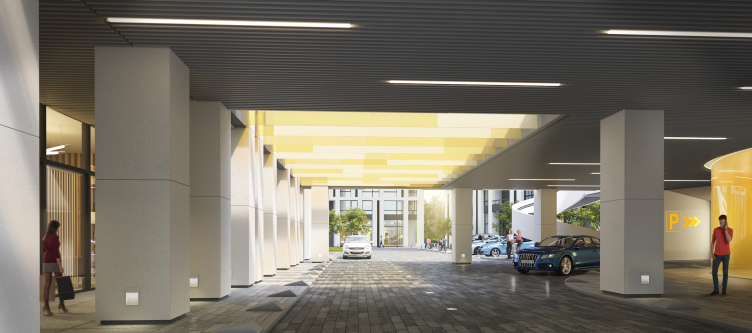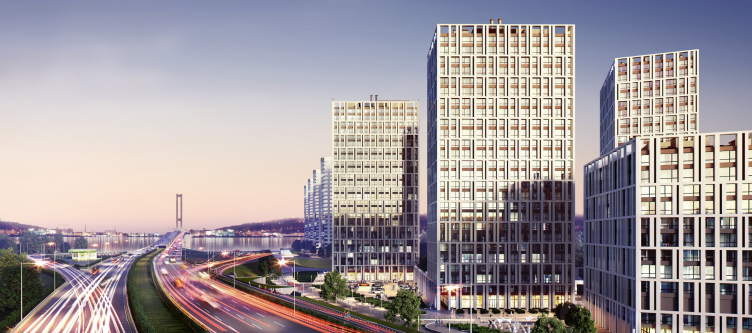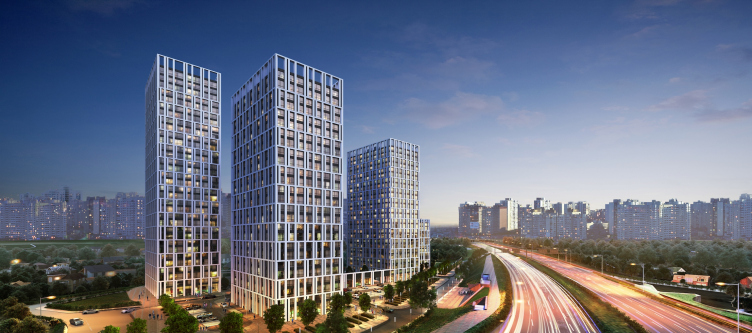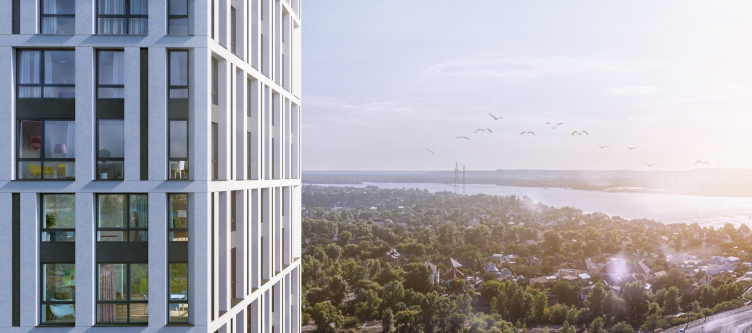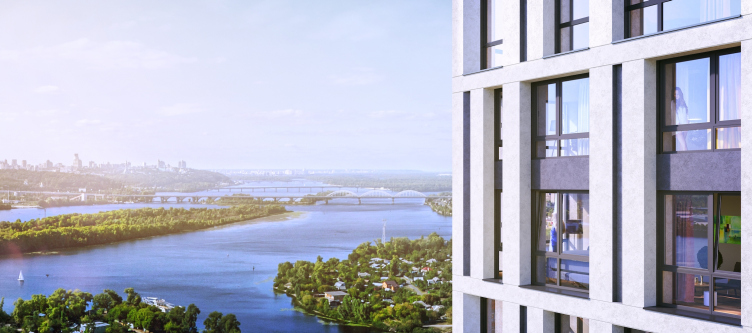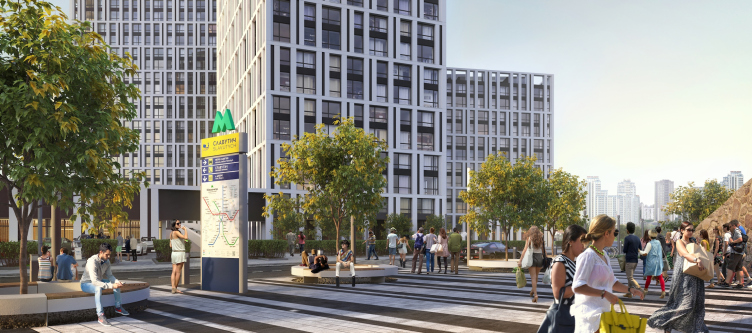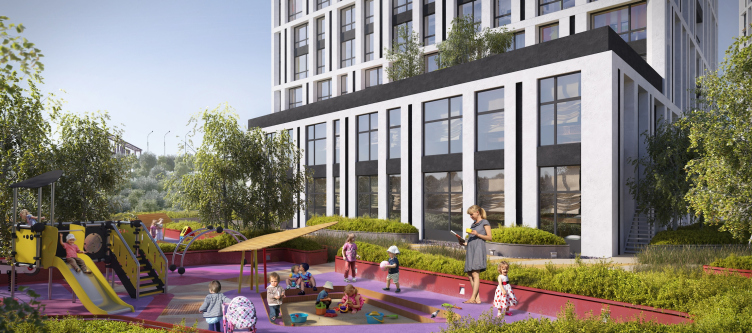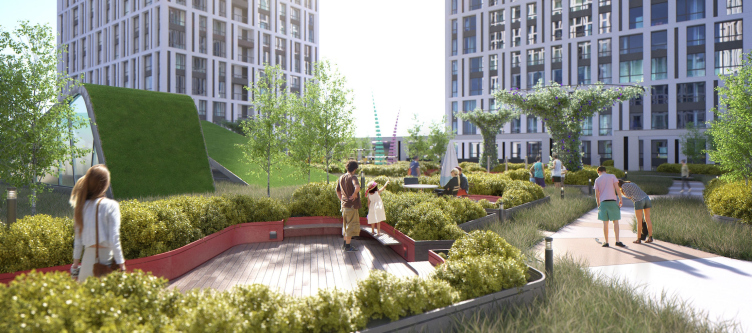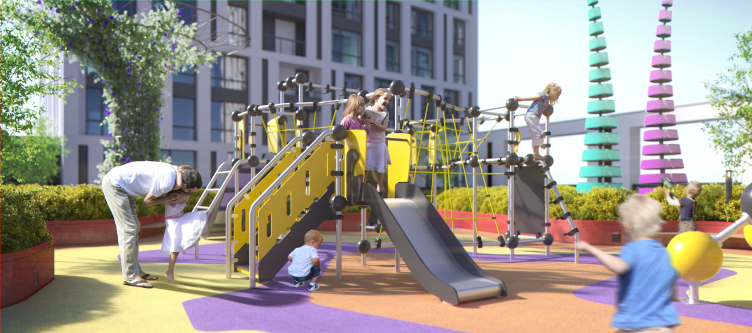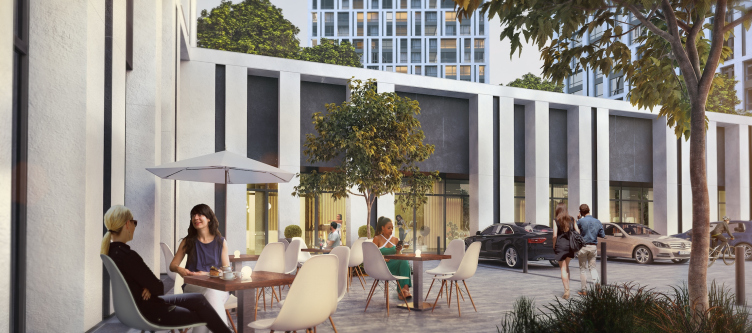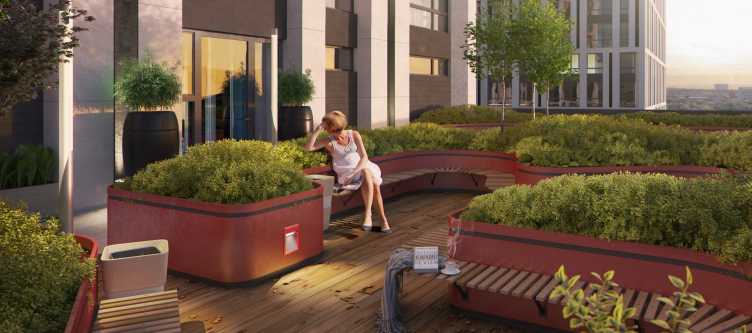Situated pretty far from the city center, this neighborhood on the left bank of the Dnipro has formed gradually since the early 1990's, and ended up being a multicolored "showcase" of controversial architectural experiments of a controversial epoch. On the other hand, this is almost a riverside resort area situated within the city limits with an abundance of trees, people's dachas, and free access to the river. "We always try to make our projects set a new trend for this or that city, and "Slavutich" is no exception - says one of the founders of "Arkhimatika", Dmitry Vasilyev - Here is the thing, though: while we always want to add color to the bleak and dreary construction of the soviet period, in this case, it is the direct opposite - in order to break away from the architectural "build-as-you-please" feast of the early 2000's, we had to completely refrain from using color and intricate designs in favor of the simple and pristine volumes. This project is a manifesto to laconism and simplicity, opting out of using "fancy" forms and silhouettes, and tiny unnecessary details. Naturally, it was formed by contrast with the existing buildings".
"Slavutich" housing project. View from the Bazhan Avenue. Project, 2016 © Arkhimatika
"Slavutich" housing project. View from the lake. Project, 2016 © Arkhimatika
The complex is situated literally across the road from the "Slavutich" metro station. The large-scale project with a total area of 122000 square meters will house more than 1200 apartments. It is situated in five towers from 12 to 26 stories high, united by a single stylobate that includes a large fitness center with an area slightly less than 3000 square meters, with gyms, studios, and swimming pools. On its roof, a pedestrian yard is created, with green zones, sports grounds and playgrounds, this yard only opened to the residents. This, seemingly obvious and logic, solution, nevertheless caused a lot of problems. "The future operator of the fitness center insisted on the swimming pool being located in the central part of the stylobate, while the light was to issue from the cheapest kind of a lateral lantern - Dmitry Vasilyev shares - in the consequence of which in the middle of the yard we would be getting a rectangle, raised about two meters above the ground, with sun tubes all along its perimeter. This "billiard table", as we called it, stopped the whole yard and was terrible in every way". The architects solved the situation by breaking the roof of the swimming pool into four strips of a trapeze-shaped plan and elevating each one of their edges in a staggered order. The side facets of the resulting triangular "teeth" will be equipped with sun tubes - which will let in the ambient light inside the swimming pool, while their upper part will be covered with soil. This technique not only allowed the architects to fulfill the client's requirements but also get an illusion of knolls upon the yard's surface.
"Slavutich" housing project. Birds-eye view. Project, 2016 © Arkhimatika
"Slavutich" housing project. Birds-eye view. Project, 2016 © Arkhimatika
"Slavutich" housing project. View from the Bazhan Avenue. Project, 2016 © Arkhimatika
"Slavutich" housing project. Section view. Project, 2016 © Arkhimatika
"Slavutich" housing project. Yard. Project, 2016 © Arkhimatika
"Slavutich" housing project. Yard. Project, 2016 © Arkhimatika
Yet another interesting solution came about as a result of separating the pedestrian and automotive traffic into two independent levels. All the driveways are situated on the ground level but at some places they are still routed under the pedestrian roof of the stylobate that forms sort of a tunnel over them. In order to keep these tunnels from looking dark and strictly utilitarian, the architects provided in some places inserts of colored glass beams that look a bit like Venetian blinds. They will also function like sun tubes, and the sun rays, passing through them, will create live colored spots on the walls and the floor, will introduce into the tunnels a play of light and shade, thus turning the tunnels into a stage for a play of sunlight.
"Slavutich" housing project. Arcade. Project, 2016 © Arkhimatika
The unusual trapeze shape of the towers and their seeming "freehand" position are actually anything but accidental: they are in fact a result of careful calculations that helped the architects provide the required insolation, at the same time getting as much useful floor space as possible.
"The traditional standard of designing Kiev's riverside housing projects is aligning three to four typical sections at a same angle - we call them "firing squads" among ourselves - shares Alexander Popov, the founder of the company - and our project is in fact surrounded by several such monotonous alignments. The last such "firing squad" is located quite near (a ridge of towers that form something like a tail that stretches away from our project into the land), and it must be launched into operation pretty soon. As for our approach, we from the very start viewed our project as a single volume, and we would "cut away" the redundant pieces, ultimately getting a single composition of five towers and a stylobate. This went a long way to help us create that "natural" feel to our project and give an air of freedom to the entire composition that looks great when viewed both from the neighboring Bazhan Avenue and from the automotive South Bridge over the Dnipro".
"Slavutich" housing project. View from the Bazhan Avenue. Project, 2016 © Arkhimatika
"Slavutich" housing project. View from the bridge. Project, 2016 © Arkhimatika
The façades are designed in the form of a geometric grid "stretched" over the glass volumes. Its pattern is mainly conditioned by the architects' desire to increase the glazing area and clear the insides of the apartments from the bearing structures. The whole outside array of pylons is placed outside of the buildings' outer walls, forming a bearing casing. This way, the architects were not only able to create a pylon-free zone along the front of the outside wall, but also get a powerful and dramatic relief of the façade, enhancing it with protrusions of the intermediate floors every two stories. There are also extra pillars that perform a purely decorative function and give extra robustness to the pattern. This will be especially noticeable in the evening because the architects plan to backlight these "slit" recessions.
"Slavutich" housing project. View from the Bazhan Avenue. Project, 2016 © Arkhimatika
"Slavutich" housing project. Main entrance. Project, 2016 © Arkhimatika
"Slavutich" housing project. Project, 2016 © Arkhimatika
"Slavutich" housing project. Project, 2016 © Arkhimatika
As for the facade decoration, its solution is rather simple - it the classic "wet" system. This has to do with the fact that in spite of the rather pristine appearance, the apartments in this complex are rather democratically priced. It is this particular fact, as well as the smart planning, saturated infrastructure, and the tasteful design which, according to the architects, yields a feeling of prestige - and secure the success of the project whose apartments enjoy a fair share of demand in spite of the difficult economic situation in the country.
The construction is already underway and is expected to be completed in 2018.
"Slavutich" housing project. Metro station. Project, 2016 © Arkhimatika
"Slavutich" housing project. Yard. Project, 2016 © Arkhimatika
"Slavutich" housing project. Kindergarten. Project, 2016 © Arkhimatika
"Slavutich" housing project. Yard. Project, 2016 © Arkhimatika
"Slavutich" housing project. Yard. Project, 2016 © Arkhimatika
"Slavutich" housing project. Fitness center. Project, 2016 © Arkhimatika
"Slavutich" housing project. Project, 2016 © Arkhimatika



